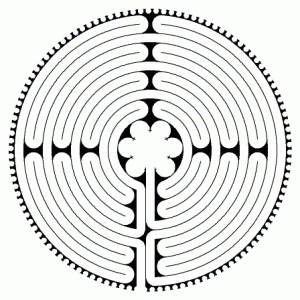Reverend Lauren Artress is an inspiring Canon at Grace Cathedral in San Francisco, and a spiritual pioneer in the Labyrinth Movement. She has written many books on the labyrinth and holds workshops around the world. Lauren’s labyrinth-based nonprofit, Veriditas, has the mission to “pepper the world with labyrinths.” You can read part one here.
Greer: Can people benefit from a onetime walk of the labyrinth?
Lauren: Absolutely. Oftentimes, when a person comes to a labyrinth for the first time, they are so ready for the labyrinth that it is an important experience for them — and then they return because it becomes such an impactful experience.
The important thing is to not set up expectations: “I had a really significant experience the first time. I am going to walk it again and have another really important experience.” That might not be what is so. Especially the second time. The second time might be a way of integrating or furthering the first labyrinth walk, but it will be different from the first time.
It’s interesting because you develop a relationship with a labyrinth; they become old friends. And I encourage people to find their own style. You need to find the style that works for you.
The two major styles are the Chartres, eleven-circuit medieval style, which is replicated from Chartres Cathedral in France, and the classical seven-circuit labyrinth. The Chartres style has 28 180-degree turns, so you are spiraling into the center in a clockwise way, turning back on yourself 28 times. The classical style does not have the 180-degree turns. They have maybe four of them at the outer edge of the turn, and the turns aren’t as tight.
This makes a difference…we don’t actually know why, but the classical labyrinth is more extraverted. You come out in a more extraverted way, ready to talk. But in the Chartres style, you come out in a more meditative mindset.
Greer: Is there any particular etiquette in a labyrinth?
Lauren: Not really. It is really important that people tailor make the labyrinth to be their own tool.
Sometimes when I talk to people who have a meditative practice that has fallen away, one of the essential ingredients of it falling away is that they are trying to do someone else’s practice. When you approach a labyrinth, you might not even know why you are doing it. But you might just want to just walk it. Sometimes people have a sense of why they are walking it, but not always.
If you are short on time, maybe you just walk into the center. We do encourage the return path if people have time, but people should tailor make it for their own walking — tailor make it for what they need rather than following strict rules around it.
Lauren’s Three Tips for Walking a Labyrinth:
1. Find and follow your natural pace. Let people move around you and move around them. The labyrinth is a two-way street. When you meet on the path, do whatever feels natural. If you want to stay in a meditative space, keep your eyes down. Or, make eye contact and smile if you feel inclined to do so. You can also meditate on the people around you if you are feeling overwhelmed by a crowd.
2. Make sure you don’t walk in with expectations; expectations take you away not toward your experience. Experience your own experience as it unfolds.
3. If you want to use a labyrinth as part of a memorial service, ceremony or ritual, hire a facilitator who is trained in holding sacred space and who can be sensitive to the needs of a larger group as a whole.
Greer: Can you tell me about how you got involved in labyrinths?
Lauren: I came across the labyrinth through Jean Houston. It was 1991, and I was thinking at that time that I needed to leave Grace Cathedral. I was the canon pastor and we had many people die of AIDS. In 1989, we had 92 people in the congregation die. People come to the cathedral if they don’t have a church but they are in trouble — they come for solace. So the whole AIDS epidemic was part of my discovery of the labyrinth, as I realized we needed a nonverbal tool that would provide solace to people.
Greer: I keep thinking about how a labyrinth integrates public and private space. Labyrinths are in public places, but people have these intense private experiences in it. Potentially, they promote community and finding solace in community.
Lauren: That’s a good point. There is a dance between public and private. That is one of the wonderful things about the labyrinth. A lot of people walk it alone. Once you step across the threshold, the labyrinth has a really clear container feeling to it. People feel very safe in the labyrinth. And again, we train facilitators to be present at the labyrinth, how to hold that space, which is a spiritual practice in itself.
Also the path is intense. This is why the Chartres style is my heartsong. It pulls people deeply into the process, because the path, I wouldn’t say is complicated, but it is certainly circuitous. The mind is doing the activity of focusing on the labyrinth. The rest of our deep intuitive nature is allowed to come forward because the mind is occupied in a very solid way, which can be helpful if we are storing a lot of emotion, like grief.
It is not unusual to see people crying when they are walking the labyrinth, even though it might be in a very public space like Grace Cathedral. The threshold has a real container feeling, which is really an important element. And it is an important element for creating community as well.
The labyrinth is excellent for use in hospices and hospitals for the staff, volunteers and employees. We have trained many people in hospice, and they are reporting that the staff is using it, because there is a lot of burnout in hospice work, if you are struggling with how to continually hold the process of death.
Greer: So, allowing the mind to focus on the labyrinth pattern is a way to access the spirit…
Lauren: Yes, especially for Westerners, and especially now, with how rapid our society is and how quick everything needs to be and how loud the external world is. We don’t have any respect for the interior world. There is very little respect for it. So stepping into the interior world by stepping into a large outer world pattern gives the mind something to do, which is a perfect practice for Westerners.
Greer: Thank you, Lauren, for such an inspiring conversation!
Lauren: Thank you.
To read Part One of this interview, click here!

 How Can a Labyrinth Help in the Grieving Process? An Interview with Lauren Artress, Part Two
How Can a Labyrinth Help in the Grieving Process? An Interview with Lauren Artress, Part Two







 “Making Mobiles” by Karolina Merska
“Making Mobiles” by Karolina Merska
 “Hands Up to the Sky” by Michael Franti & Spearhead
“Hands Up to the Sky” by Michael Franti & Spearhead
 Coping With Election Grief
Coping With Election Grief















Thanks so much for this wonderful and informative interview! I’ve added links to both parts at the base of an article that appears on my own blog, “Voices of Experience: The Labyrinth of Grief,” here: j.mp/JaD9ZI
Report this comment
Thanks Marty! Yes isn’t it an amazing one. We have been wanting to cover this topic and Lauren Artress offered us such a lovely interview. I was excited to read about how labyrinths can be incorporated into the healing process.
Report this comment